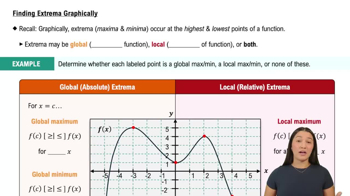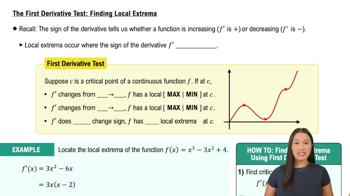Table of contents
- 0. Functions7h 52m
- Introduction to Functions16m
- Piecewise Functions10m
- Properties of Functions9m
- Common Functions1h 8m
- Transformations5m
- Combining Functions27m
- Exponent rules32m
- Exponential Functions28m
- Logarithmic Functions24m
- Properties of Logarithms34m
- Exponential & Logarithmic Equations35m
- Introduction to Trigonometric Functions38m
- Graphs of Trigonometric Functions44m
- Trigonometric Identities47m
- Inverse Trigonometric Functions48m
- 1. Limits and Continuity2h 2m
- 2. Intro to Derivatives1h 33m
- 3. Techniques of Differentiation3h 18m
- 4. Applications of Derivatives2h 38m
- 5. Graphical Applications of Derivatives6h 2m
- 6. Derivatives of Inverse, Exponential, & Logarithmic Functions2h 37m
- 7. Antiderivatives & Indefinite Integrals1h 26m
- 8. Definite Integrals4h 44m
- 9. Graphical Applications of Integrals2h 27m
- 10. Physics Applications of Integrals 2h 22m
5. Graphical Applications of Derivatives
Intro to Extrema
Problem 4.R.2a
Textbook Question
Locating extrema Consider the graph of a function ƒ on the interval [-3, 3]. <IMAGE>
a . Give the approximate coordinates of the local maxima and minima of ƒ
 Verified step by step guidance
Verified step by step guidance1
Identify the critical points of the function ƒ by finding where the derivative ƒ'(x) is zero or undefined within the interval [-3, 3].
Evaluate the function ƒ at each critical point to determine the function values at these points.
Examine the endpoints of the interval, x = -3 and x = 3, by evaluating ƒ at these points to ensure no extrema are missed.
Compare the function values at the critical points and endpoints to determine which are local maxima and which are local minima.
Approximate the coordinates of the local maxima and minima by identifying the x-values where the function has the highest and lowest values, respectively, and pairing them with their corresponding function values.
 Verified video answer for a similar problem:
Verified video answer for a similar problem:This video solution was recommended by our tutors as helpful for the problem above
Video duration:
2mPlay a video:
Was this helpful?
Key Concepts
Here are the essential concepts you must grasp in order to answer the question correctly.
Local Extrema
Local extrema refer to the points on a function where it reaches a local maximum or minimum value within a specific interval. A local maximum is a point where the function value is higher than its immediate neighbors, while a local minimum is where it is lower. Identifying these points often involves analyzing the function's derivative.
Recommended video:

Finding Extrema Graphically
Critical Points
Critical points are values in the domain of a function where its derivative is either zero or undefined. These points are essential for finding local extrema, as they indicate where the function's slope changes, potentially leading to maxima or minima. Evaluating the function at these points helps determine their nature.
Recommended video:

Critical Points
First Derivative Test
The First Derivative Test is a method used to classify critical points as local maxima, local minima, or neither. By examining the sign of the derivative before and after a critical point, one can determine whether the function is increasing or decreasing, thus identifying the nature of the extrema. This test is a fundamental tool in calculus for analyzing function behavior.
Recommended video:

The First Derivative Test: Finding Local Extrema

 5:58m
5:58mWatch next
Master Finding Extrema Graphically with a bite sized video explanation from Callie
Start learning




